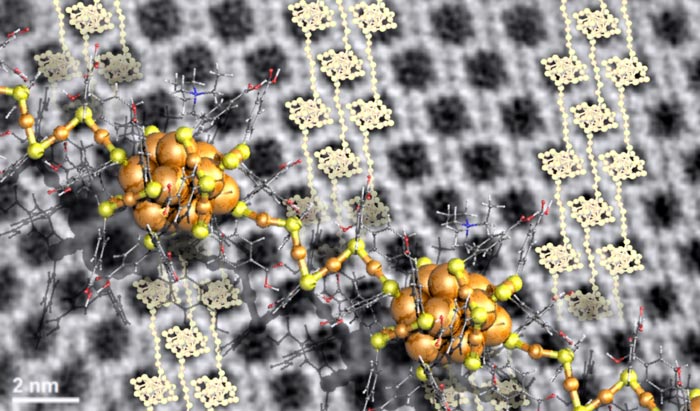Researchers learn to engineer growth of crystalline materials consisting of nanometer-size gold clusters

Electron microscopy image (background) of an ordered crystal consisting of 25-atom gold clusters. The data could be interpreted by a model of tightly packed polymeric chains of the clusters (light spheres). A close-up visualization of two such clusters, connected by a gold-ligand chain is shown in front. Graphics: Sami Malola, University of Jyväskylä
Credit: University of Jyvaskyla/Sami Malola
First insights into engineering crystal growth by atomically precise metal nanoclusters have been achieved in a study performed by researchers in Singapore, Saudi Arabia and Finland. The work was published in Nature Chemistry on November 10, 2022.
Ordinary solid matter consists of atoms organized in a crystal lattice. The chemical character of the atoms and lattice symmetry define the properties of the matter, for instance, whether it is a metal, a semiconductor or and electric insulator. The lattice symmetry may be changed by ambient conditions such as temperature or high pressure, which can induce structural transitions and transform even an electric insulator to an electric conductor, that is, a metal.
Larger identical entities such as nanoparticles or atomically precise metal nanoclusters can also organize into a crystal lattice, to form so called meta-materials. However, information on how to engineer the growth of such materials from their building blocks has been scarce since the crystal growth is a typical self-assembling process.
Now, first insights into engineering crystal growth by atomically precise metal nanoclusters have been achieved in a study performed by researchers in Singapore, Saudi Arabia and Finland. They synthesized metal clusters consisting of only 25 gold atoms, one nanometer in diameter. These clusters are soluble in water due to the ligand molecules that protect the gold. This cluster material is known to self-assemble into well-defined close packed single crystals when the water solvent is evaporated. However, the researcher found a novel concept to regulate the crystal growth by adding tetra-alkyl-ammonium molecular ions in the solvent. These ions affect the surface chemistry of the gold clusters, and their size and concentration were observed to have an impact on the size, shape, and morphology of the formed crystals. Remarkably, high-resolution electron microscopy images of some of the crystals revealed that they consist of polymeric chains of clusters with four-gold-atom interparticle links (see the Figure). The demonstrated surface chemistry opens now new ways to engineer metal cluster -based meta-materials for investigations of their electronic and optical properties.
The cluster materials were synthesized in the National University of Singapore, the electron microscopy imaging was done at the King Abdullah University of Science and Technology in Saud Arabia, and the theoretical modelling was done at the University of Jyvaskyla, Finland. The work was published in Nature Chemistry on November 10, 2022: https://www.nature.com/articles/s41557-022-01079-9
Contacts:
Prof. Jianping Xie, National University of Singapore, chexiej@nus.edu.sg
Prof. Yu Han, King Abdullah University of Science and Technology, yu.han@kaust.edu.sa
Prof. Hannu Häkkinen, University of Jyväskylä, hannu.j.hakkinen@jyu.fi
Journal: Nature Chemistry
DOI: 10.1038/s41557-022-01079-9
Method of Research: Experimental study
Subject of Research: Not applicable
Article Title: Supercrystal engineering of atomically precise gold nanoparticles promoted by surface dynamics
Article Publication Date: 10-Nov-2022
All latest news from the category: Life Sciences and Chemistry
Articles and reports from the Life Sciences and chemistry area deal with applied and basic research into modern biology, chemistry and human medicine.
Valuable information can be found on a range of life sciences fields including bacteriology, biochemistry, bionics, bioinformatics, biophysics, biotechnology, genetics, geobotany, human biology, marine biology, microbiology, molecular biology, cellular biology, zoology, bioinorganic chemistry, microchemistry and environmental chemistry.
Newest articles

NASA: Mystery of life’s handedness deepens
The mystery of why life uses molecules with specific orientations has deepened with a NASA-funded discovery that RNA — a key molecule thought to have potentially held the instructions for…

What are the effects of historic lithium mining on water quality?
Study reveals low levels of common contaminants but high levels of other elements in waters associated with an abandoned lithium mine. Lithium ore and mining waste from a historic lithium…

Quantum-inspired design boosts efficiency of heat-to-electricity conversion
Rice engineers take unconventional route to improving thermophotovoltaic systems. Researchers at Rice University have found a new way to improve a key element of thermophotovoltaic (TPV) systems, which convert heat…



